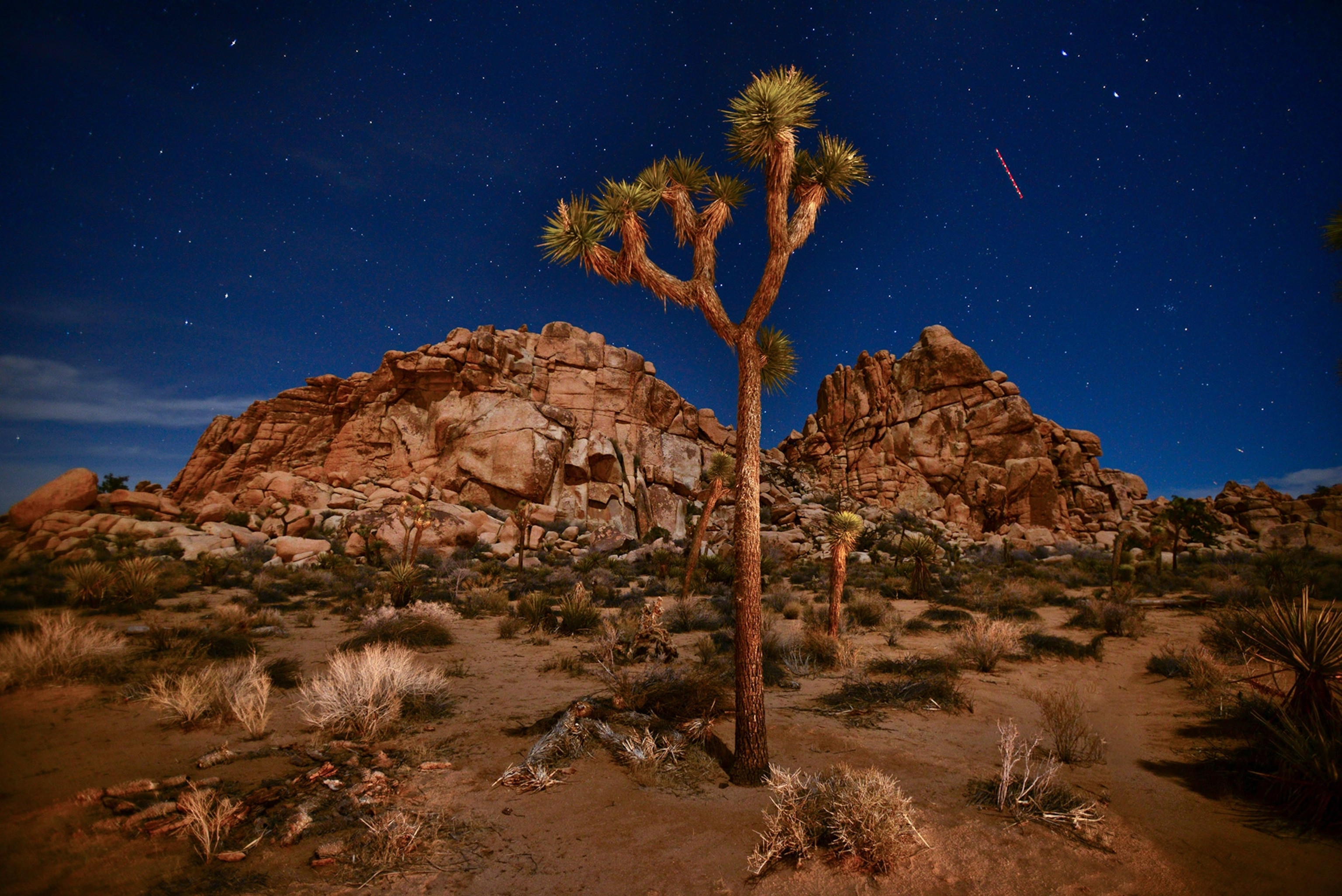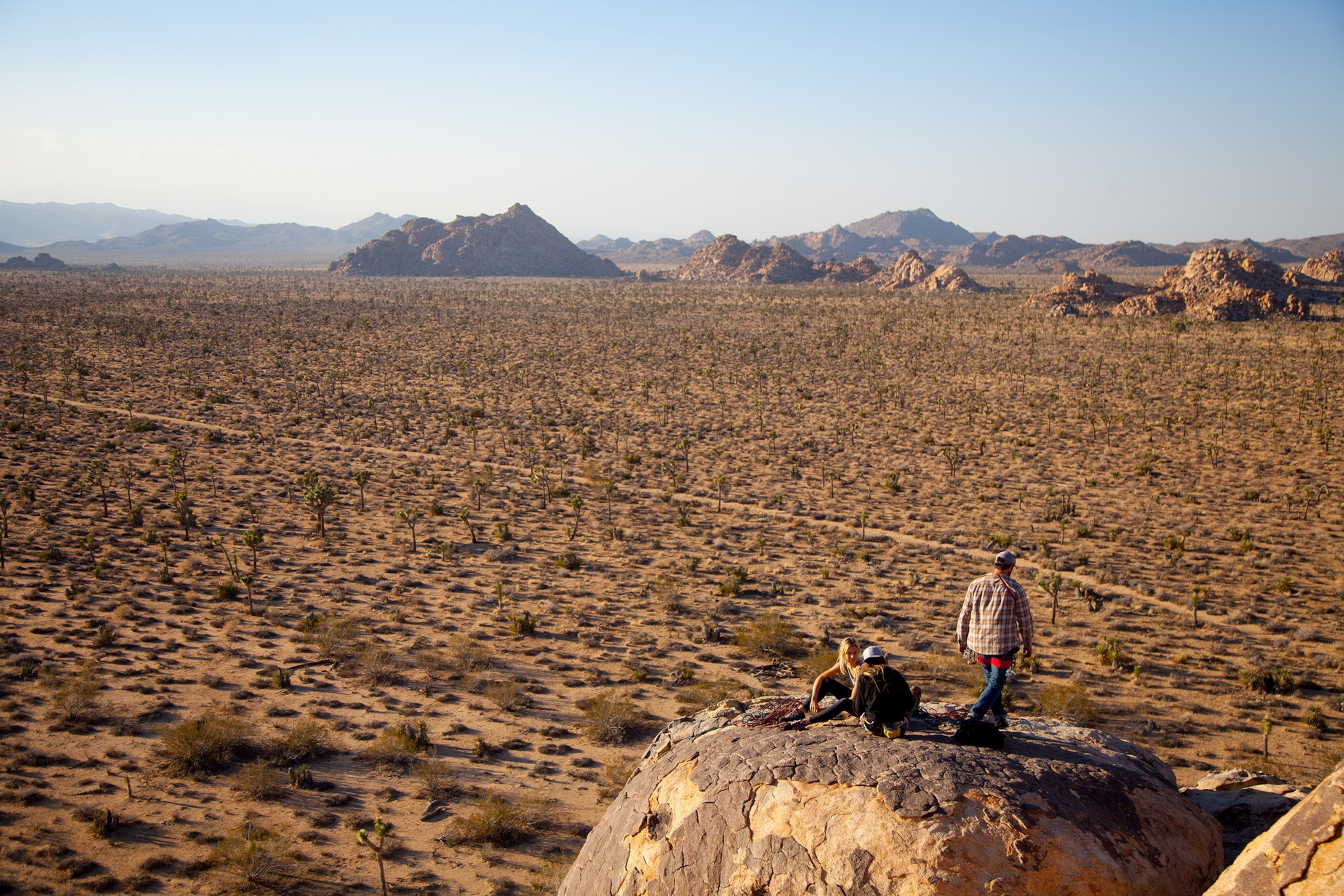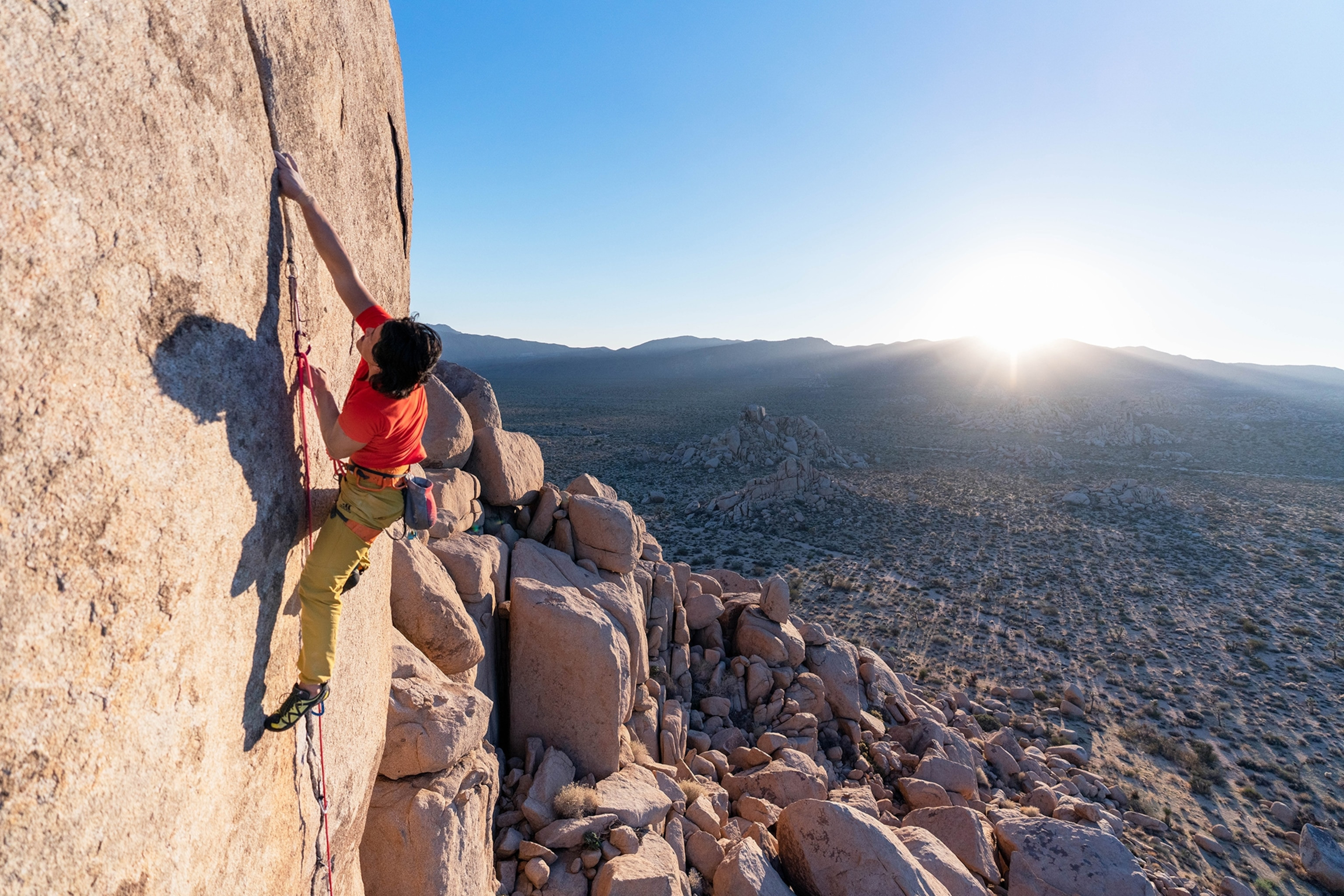 Joshua trees lit by moonlight in Joshua Tree National Park.
Joshua trees lit by moonlight in Joshua Tree National Park.
For those captivated by the stark beauty of the desert and the unique silhouette of the Joshua tree, a common question arises: Where Is Joshua Tree? Joshua Tree National Park, a beloved natural treasure, is nestled in Southern California, where the arid low desert of the Colorado and the higher, cooler Mojave Desert converge. This remarkable park is more than just a location; it’s a meeting point of ecosystems, a haven for adventurers, and a place of profound natural beauty that draws millions of visitors each year. Located east of Los Angeles and north of Palm Springs, Joshua Tree offers an accessible escape into a landscape unlike any other, promising stunning vistas and unforgettable experiences.
Discovering the Location of Joshua Tree National Park
Joshua Tree National Park’s unique appeal is intrinsically linked to its geographical setting. Spanning across parts of San Bernardino and Riverside counties in Southern California, the park is strategically positioned at the crossroads of two distinct desert environments. This convergence is not merely a point on a map; it’s the very essence of Joshua Tree’s ecological diversity and scenic contrasts.
The western section of Joshua Tree falls within the Mojave Desert, often referred to as the “High Desert” due to its higher elevation. This area is characterized by the iconic Joshua trees (Yucca brevifolia) that lend the park its name, along with vast sandy plains punctuated by dramatic granite rock formations. These impressive rock monoliths and piles, sculpted by millennia of natural forces, are a defining feature of the Mojave Desert landscape within Joshua Tree.
In contrast, the eastern part of the park transitions into the Colorado Desert, or “Low Desert.” Here, the elevation gradually decreases, and temperatures tend to be warmer. While appearing more sparsely vegetated at first glance, the Colorado Desert section of Joshua Tree reveals its own subtle beauty through vibrant desert gardens of ocotillo and cholla cactus. This desert, while seemingly stark, is teeming with life adapted to the harsher conditions.
Joshua Tree’s location also places it within reach of major urban centers and popular destinations. It’s approximately a 2 to 3-hour drive east of Los Angeles, making it a popular weekend getaway for city dwellers seeking nature and solitude. Palm Springs, a well-known desert resort city, lies to the south of the park and serves as another convenient gateway. The towns of Joshua Tree, Yucca Valley, and Twentynine Palms are situated closest to the park’s entrances, offering visitor services and accommodations.
This strategic location makes Joshua Tree National Park accessible yet wonderfully remote, allowing visitors to easily immerse themselves in the tranquility and grandeur of the desert landscape.
 Climbers rest on top of a rock before rappelling back to the valley floor in Joshua Tree National Park.
Climbers rest on top of a rock before rappelling back to the valley floor in Joshua Tree National Park.
Navigating Your Way to Joshua Tree
Reaching Joshua Tree National Park is straightforward, with well-marked routes from major Southern California cities. Whether you’re coming from the bustling streets of Los Angeles or the relaxing vibes of Palm Springs, planning your route is the first step to experiencing the park’s wonders.
For visitors traveling from Los Angeles, the most common route involves taking Interstate 10 (I-10) east towards Indio. From I-10, you can access different entrances to Joshua Tree National Park. To reach the west entrance near Joshua Tree and Yucca Valley, you’ll take Highway 62 (also known as the Twentynine Palms Highway) north. This route is approximately 120 miles from Los Angeles and leads you directly to the heart of the Mojave Desert section of the park.
If your destination is the north entrance near Twentynine Palms, continue slightly further east on I-10 before again taking Highway 62 north. This entrance is around 142 miles from Los Angeles and provides access to the Oasis Visitor Center and the northern parts of the park.
For those approaching from the south or east, particularly from areas like Palm Springs or Indio, the south entrance at Cottonwood Springs is the most convenient. From I-10, exit at Cottonwood Springs Road and follow the signs to the park entrance. This route is about 160 miles from Los Angeles and offers immediate access to the Colorado Desert landscape within Joshua Tree.
Regardless of your chosen entrance, it’s important to note that entrance fees apply. Currently, the fee is $30 per vehicle, $25 per motorcycle, and $15 per individual, although it’s always wise to check the official National Park Service (NPS) website for the most up-to-date fee information before your visit.
Upon entering the park, you’ll find visitor centers at each of the main entrances: Joshua Tree Visitor Center near the west entrance, Oasis Visitor Center near the north entrance, and Cottonwood Visitor Center at the south entrance. These centers are invaluable resources for maps, park information, ranger advice, and exhibits that enhance your understanding and appreciation of Joshua Tree National Park.
Exploring the Diverse Landscapes Within Joshua Tree
Once you’ve arrived at Joshua Tree National Park, a world of exploration awaits, offering a diverse range of landscapes and activities across its vast expanse. Understanding the layout of the park helps you make the most of your visit, whether you’re seeking panoramic views, challenging hikes, or encounters with desert wildlife.
For breathtaking panoramic vistas, Keys View stands out as an iconic location. Situated on the crest of the Little San Bernardino Mountains, Keys View offers a mile-high perspective of the Coachella Valley. From this vantage point, you can gaze out over the Salton Sea, Mount San Jacinto, the San Andreas Fault, and the Anza-Borrego Desert on a clear day. Visiting Keys View at dusk is particularly rewarding, as the city lights of Palm Springs and Indio begin to twinkle across the valley.
Hikers of all levels will find trails to suit their preferences within Joshua Tree. For an easy introduction to the park’s wonders, consider the short nature trails in the Hidden Valley area, such as Hidden Valley Trail, Barker Dam Trail, and Cap Rock Trail. These trails, each a mile or less in length, provide close-up views of the unique rock formations and desert vegetation. For a more strenuous hike with rewarding views, Ryan Mountain Trail climbs to 5,456 feet, offering bird’s-eye perspectives of Hidden Valley and Queen Valley. Longer, more challenging trails like the Boy Scout Trail and the California Riding & Hiking Trail cater to experienced backpackers seeking deeper wilderness immersion. Trailheads for many of these hikes are located throughout the Hidden Valley and Cottonwood areas, easily accessible from the main park roads.
Wildlife enthusiasts should know that Joshua Tree is home to a variety of desert creatures, though many are most active during the cooler hours of dawn and dusk. Keys View and the Wonderland of Rocks north of Hidden Valley are known locations for spotting desert bighorn sheep, the park’s largest mammal. Keep an eye out for jackrabbits and cottontails near campgrounds, ground squirrels around boulders, and lizards along trails. For birdwatching, oases like Oasis of Mara, Barker Dam, Desert Queen Ranch, and Cottonwood Spring attract a variety of species, including turkey vultures, kestrels, and red-tailed hawks. Remember to be patient and observant, and you may be rewarded with glimpses of Joshua Tree’s diverse fauna.
To experience the park’s premier attractions, a leisurely auto tour along the main park roads is highly recommended. Park Boulevard, starting from the Joshua Tree Visitor Center, traverses the western half of the park, leading to Hidden Valley, Cap Rock, and Keys View. Continuing along Park Boulevard takes you through Sheep Pass and into Queen Valley, home to a dense Joshua tree forest and the starting point for the Geology Tour Road. This 18-mile loop road features 16 stops that explain the geological forces that shaped the park’s dramatic landscape. In the eastern part of the park, Pinto Basin Road explores the Colorado Desert section, showcasing cholla cactus gardens, ocotillo, and cottonwood trees, with the Cholla Cactus Garden being a particularly popular stop. Cottonwood Visitor Center, located in the southeast corner, provides access to trails leading to Mastodon Peak and Lost Palms Oasis, further expanding your exploration options within Joshua Tree.
 A rock climber working his way up a technical granite face.
A rock climber working his way up a technical granite face.
Planning Your Visit: Essential Information for Joshua Tree
To ensure a smooth and enjoyable trip to Joshua Tree National Park, consider these essential planning details, focusing on making the most of your time in this unique location.
Visitor centers are key starting points for any visit. The Joshua Tree Visitor Center, located just outside the west entrance in the town of Joshua Tree, is open year-round and offers park information, exhibits, and ranger programs. The Oasis Visitor Center, near the north entrance in Twentynine Palms, also provides similar services and is situated near the Oasis of Mara. Cottonwood Visitor Center, at the south entrance, focuses on the Colorado Desert environment and hiking opportunities in that region. Black Rock Nature Center and Campground, while smaller, offers information and serves the Black Rock Canyon area in the northwest part of the park. Checking the operating hours of these centers before your visit is advisable, as they may vary seasonally.
The best time to visit Joshua Tree is generally during the spring and fall. These seasons offer the most comfortable temperatures, with average highs around 85°F and lows around 50°F. Spring is also wildflower season, with blooms typically starting at lower elevations in January or February and peaking park-wide from April to June, adding vibrant colors to the desert landscape. Winter brings cooler days, around 60°F, but nights can be freezing, and snow is possible at higher elevations. Summers in Joshua Tree are extremely hot, with midday temperatures often exceeding 100°F, making outdoor activities challenging during peak hours.
For overnight stays, camping within Joshua Tree National Park is a highly immersive experience. Eight campgrounds offer over 500 sites in total. Campgrounds like Jumbo Rocks, Ryan Campground, and Black Rock Campground are reservable in advance through Recreation.gov, while others such as Hidden Valley, White Tank, and Indian Cove are first-come, first-served. Reservations are highly recommended, especially during peak season from October through May and on holiday weekends, as campgrounds often fill up early. If camping isn’t your preference, the towns surrounding Joshua Tree – Joshua Tree, Yucca Valley, and Twentynine Palms – offer a range of hotels and lodging options. Palm Springs and other Coachella Valley cities are also within driving distance, about an hour away, providing additional accommodation choices.
Park access is available 24 hours a day, year-round, through the three main entrances. Entrance fees are required upon entry. As mentioned earlier, fees are subject to change, so verifying the current rates on the NPS website is recommended. It’s also worth noting that during peak season, particularly on weekends and holidays, entrance station lines can be lengthy, especially between 10 a.m. and 2 p.m. Planning your arrival time accordingly can help minimize wait times.
Joshua Tree National Park is committed to accessibility. All visitor centers are wheelchair accessible, with accessible parking, information desks, and restrooms. Select campgrounds, such as Jumbo Rocks and Indian Cove, offer accessible campsites and facilities. Picnic areas at Hidden Valley and Quail Springs are also accessible. For trails, the paved paths at Oasis of Mara and Keys View are the most suitable for wheelchairs. The park map and brochure are available in braille and large print, and tactile exhibits are located at various points throughout the park, ensuring that Joshua Tree’s wonders can be enjoyed by as many people as possible.
Joshua Tree National Park is more than just a point on a map; it’s a destination that captivates with its unique location, where two distinct deserts merge to create a landscape of unparalleled beauty and ecological richness. From the iconic Joshua trees to the dramatic rock formations, from the vibrant spring wildflowers to the star-studded night skies, Joshua Tree offers an extraordinary experience for every visitor. Plan your journey, discover where Joshua Tree is, and prepare to be amazed by the wonders of this exceptional national park.
